Decoding the Supreme Court’s Split Verdict on Hijab Ban

Due to the split verdict, the matter has been placed before the Chief Justice of India for constituting a larger bench.
—-
Today morning, a division bench of the Supreme Court, comprising Justices Hemant Gupta and Sudhanshu Dhulia, delivered a split verdict in the petitions challenging the Karnataka High Court’s judgment from earlier this year, which upheld the Karnataka government’s ban on female students wearing the hijab in educational institutions in Karnataka based on the Karnataka Government Order on Dress Code for Students and the Karnataka Education Act, 1983.
Justice Gupta dismissed all the appeals and the writ petitions, whereas Justice Dhulia allowed all the appeals as well as the writ petitions, setting aside the high court’s decision, quashing the government order, and uplifting restrictions on the wearing of hijab anywhere in schools and colleges in Karnataka.
The Leaflet breaks down the judgment and its rationale:
What does Justice Gupta’s judgment say?
Justice Gupta framed the following eleven questions raised in the case, and answered each of them in favour of the Karnataka government’s order:
“(i) Whether the appeals should be heard along with Kantaru Rajeevaru (Right to Religion, In Re) and/or should the present appeals be referred to the Constitution Bench in terms of Article 145(3) of the Constitution?”
He answered this negatively, because the issue in the present case, as to whether students can enforce their religious beliefs in a secular institution, doesn’t, according to him involve a substantial question of law as to the interpretation of the Constitution “only for the reason that the right claimed by the appellants is provided under the Constitution”. Hence, he decides that there is no need to refer it to a larger bench or hear it along with Kantaru Rajeevaru.
“(ii) Whether the State Government could delegate its decision to implement the wearing of uniform by the College Development Committee or the Board of Management and whether the Government Order insofar as it empowers a College Development Committee to decide on the restriction/prohibition 21 or otherwise on headscarves is ex facie violative of Section 143 of the [Karnataka Education Act]?”
Holding that executive powers can be used to supplement the statutory rules, Justice Gupta did not find that the constitution of the College Development Committee contravenes any of the provisions of the Karnataka Education Act or the Rules made thereunder, or that the regulation of uniform by such Committee is beyond its scope.
“(iii) What is ambit and scope of the right to freedom of ‘conscience’ and ‘religion’ under Article 25?”
Justice Gupta held that the object of the Government Order was to ensure parity amongst the students in terms of uniform, promote uniformity and encourage a secular environment in the schools. This, according to him, is in consonance with the right guaranteed under Article 14 of the Constitution. Hence, he held that “restrictions on freedom of religion and conscience have to be read conjointly along with other provisions of Part III as laid down under the restrictions of Article 25(1).”
“(iv) What is the ambit and scope of essential religious practices under Article 25 of the Constitution?”
Justice Gupta adjudicated that since Article 25(2) is negatively worded, “if the State seeks to regulate the economic, political, financial or other secular aspects connected with religion, the State law is to have primacy over the proposed right. Similarly, if a particular practice/belief/part of any religion is in existence and is found to be subjected to either “social welfare” and “reform”, such right will have to give way to “social welfare” and “reform”.”
He explains that wearing of headscarf is based on the belief or faith of an individual, and that this religious belief cannot be carried to a secular school maintained out of State funds. It is open to the students to carry their faith in a school which permits them to do so, but the State is within its jurisdiction to direct that apparent symbols of religious beliefs not be carried to schools maintained by the State from the State funds. Thus, he held that the practice of wearing hijab could be restricted by the State in terms of the Government Order
“(v) Whether fundamental rights of freedom of expression under Article 19(1)(a) and right of privacy under Article 21 mutually exclusive or are they complementary to each other; and whether the Government Order does not meet the injunction of reasonableness for the purposes of Article 21 and Article 14?”
Justice Gupta noted that none of the fundamental rights are absolute, and that the curtailment of fundamental rights is permissible by following due procedure which is reasonable. According to him, the intent and object of the Government Order is to maintain uniformity amongst the students by adherence to the prescribed uniform. To that extend, it is a reasonable regulation of the right under Article 19(1)(a). Additionally, he held that “the right of freedom of expression under Article 19(1)(a) and of privacy under Article 21 are complementary to each other and not mutually exclusive and does meet the injunction of reasonableness for the purposes of Articles 21 and 14.”
“(vi) Whether the Government Order impinges upon Constitutional promise of fraternity and dignity under the Preamble as well as fundamental duties enumerated under Article 51-A sub-clauses (e) and (f)?”
Justice Gupta held that the Government Order actually promotes an equal environment in whichnfraternal values can be imbibed and nurtured without any hindrance. On the other hand, in his view, the concept of fraternity would stand fragmented if students are permitted to wear the hijab inside the classroom, as “the apparent distinction of some of the students wearing headscarf would not form a homogenous group of students in a school where education is to be imparted homogeneously and equally, irrespective of any religious identification mark. The Constitutional goal of fraternity would be defeated if the students are permitted to carry their apparent religious symbols with them to the classroom.”
He notes that the prescribed uniform would lose its meaning if students are permitted to add or subtract any part of it. He reiterates that in a secular, State-aided school, the State is competent to not permit anything other than the uniform.
He also brushed aside the argument that the wearing of a headscarf provides dignity to girl students, since the students are attending an all-girls’ college. He holds that the students are at liberty to carry their religious symbols outside the schools but in preuniversity college, they must “look alike, feel alike, think alike and study together in a cohesive cordial atmosphere.”
“(vii) Whether, if the wearing of hijab is considered as an essential religious practice, the student can seek right to wear headscarf to a secular school as a matter of right?”
Justice Gupta held that students are required to follow the discipline of the school in the matter of uniform, and that they have no right to be in the school in violation of the mandate of the uniform prescribed by the State under a statute.
“(viii) Whether a student-citizen in the constitutional scheme is expected to surrender her fundamental rights under Articles 19, 21 and 25 as a pre-condition for accessing education in a State institution?”
Justice Gupta held that the right to education continues to be available to all students in spite of the Government Order, and it is the choice of the student to avail such right or not. The student cannot put a condition that unless she is permitted to come to a secular school wearing a headscarf, she would not attend the school. It is the student who is deciding not to adhere to the uniform rules, not of the school.
“(ix) Whether in the constitutional scheme, the State is obligated to ensure ‘reasonable accommodation’ to its citizens?”
Justice Gupta held that though the principle of reasonable accommodation has been adopted by courts in our country, it does not arise in the present matter. As per him, Constitutional goals such as secularism, fraternity and dignity denote equality for all and preference to none. The accommodation sought by the petitioners, thus, is contrary to the spirit of Article 14 as it would result in different treatment of students in secular schools who may be following different religious beliefs.
“(x) Whether the Government Order is contrary to the legitimate State interest of promoting literacy and education as mandated under Articles 21, 21A, 39(f), 41, 46 and 51A of the Constitution?”
Justice Gupta held that the Government Order cannot be said to be contrary to the legitimate State goal of promoting literacy and education. For one, Article 21A is not applicable in the case as all the students are over 14 years of age. The students do have a right to education under Article 21, but not of insisting on wearing something additional to the prescribed uniform.
He opines that the “Government Order only ensures that the uniform prescribed is adhered to by the students and it cannot be said that State is restricting the access to education to the girl students through such an Order.”
“(xi) Whether the Government Order neither achieves any equitable access to education, nor serves the ethic of secularism, nor is true to the objective of the Karnataka Education Act?”
Justice Gupta held that school uniform fosters equality, unity and discipline. Since secularism is applicable to all citizens, therefore, permitting one religious community to wear their religious symbols would be antithetical to secularism, he holds. Thus, he decides that the Government Order cannot be said to be against the ethic of secularism or to the objective of the Karnataka Education Act.
What does Justice Dhulia’s judgment say?
Justice Dhulia begins his judgment by discussing the four questions framed by the high court, and its rationale behind how it answered each one.
He holds that the question of Essential Religious Practices (‘ERP’) was not at all relevant in the determination of the dispute. He reasons that when protection is sought under Article 25(1) of the Constitution, as is being done in the instant case, the establishment of an ERP is not required, because it may simply be any religious practice, a matter of faith or conscience.
He opines that instead of straightaway taking the ERP route as a threshold requirement, the high court should have first examined whether the restrictions were valid, or they were hit by the doctrine of proportionality.
Differentiating the court’s jurisprudence on ERP, he notes that a case of assertion of individual right is different from those of community rights: whereas Article 25(1) deals with individual rights, Article 25(2) and Article 26 deal with community-based rights. Since the court’s ERP jurisprudence deals with the latter, it is not relevant in the instance case.
He holds that whether wearing hijab is an ERP in Islam or not is not essential for the determination of this dispute. In his view, “if the belief is sincere, and it harms no one else, there can be no justifiable reasons for banning hijab in a classroom.”
He further opines that courts must not attempt to solve theological questions. They must only intervene when Constitutional provisions are violated.
Next, he explains that the court’s Bijoe Emmanuel judgment of 1986 must be considered, since its ratio applies to the instance case.
He admits that it is necessary to have discipline in schools, but not at the cost of freedom or dignity. He holds that asking a pre university schoolgirl to take off her hijab at her school gate is an invasion on her privacy and dignity, and clearly violative of her fundamental rights under Article 19(1)(a) and 21.
He asks what is more important: the education of a girl child or the enforcement of a dress code. He also questions if the life of a girl child is being made any better by denying her education, merely because she wears a hijab.
He holds that a girl child “has the right to wear hijab in her house or outside her house, and that right does not stop at her school gate. The child carries her dignity and her privacy even when she is inside the school gates, in her classroom.”
He also holds that the Government Order restricting the wearing of hijab militates against the constitutional values of fraternity and human dignity. This is because, according to him, fraternity would require tolerance and accommodation towards the beliefs and religious practices of others. He also stressed on the importance of accepting and inculcating the respect for diversity among students.
He concludes that under our Constitutional scheme, wearing a hijab is simply a matter of choice. “It may or may not be a matter of essential religious practice, but it still is a matter of conscience, belief, and expression. “If she wants to wear hijab, even inside her class room, she cannot be stopped, if it is worn as a matter of her choice,” he notes. Further, he also points out that the hijab restriction will have the unfortunate and unintended ramification of denying education to many girls. He elaborates on this by discussing the challenges that girls face in accessing education.
He concludes that “[b]y asking the girls to take off their hijab before they enter the school gates, is first an invasion on their privacy, then it is an attack on their dignity, and then ultimately it is a denial to them of secular education. These are clearly violative of Article 19(1)(a), Article 21 and Article 25(1) of the Constitution of India.”
Click here to view the Supreme Court’s full judgment.
Delhi-based lawyer and Assistant Editor at The Leaflet.
Get the latest reports & analysis with people's perspective on Protests, movements & deep analytical videos, discussions of the current affairs in your Telegram app. Subscribe to NewsClick's Telegram channel & get Real-Time updates on stories, as they get published on our website.
























